New figures from a team of mathematicians and scientists modelling the way Covid-19 could affect New Zealand indicate the lockdown has significantly dampened the spread of the virus.
The University of Auckland’s Te Pūnaha Matatini had published a paper after the lockdown start showing that 80,000 New Zealanders could have been killed if no action was taken to stop the virus.
Now, the same team shows that New Zealand could have had 200 new cases of Covid-19 today had there been no lockdown. Instead, we had 29.
“The lockdown has actually worked, which means people have taken it seriously. We need to continue to take it seriously for a while yet – some of our simulations show that if we take our foot off the brake, we could easily have another outbreak that could get out of control,” the paper’s lead author and Te Pūnaha Matatini director Shaun Hendy told Newsroom.
“While case numbers remain low, population-wide control methods combined with efficient tracing, testing, and case isolation, offer the opportunity for New Zealand to contain and eliminate Covid-19,” the paper states.
In particular, the speed of case isolation is key to containing or eliminating the virus. If the time between when a person is infected and when they go into isolation is too long, then the potential for a second outbreak rises.
“We find that fast tracing and case isolation (i.e. operations that are sustained at rates comparable to that at the early stages of New Zealand’s response) can lead to containment or elimination, as long as strong population-wide controls remain in place. Slow case isolation can lead to containment (but not elimination) as long as strong Level 4 population-wide controls remain in place,” the paper says.
Even more crucial to determining outcomes, however, is the effectiveness of the control measures. The authors observed that similar measures undertaken overseas have put out a range of results, with the United Kingdom struggling to manage an effective lockdown while countries like Denmark wrestle the virus under control.
Based on this, the researchers laid out three possibilities: a pessimistic scenario, a realistic scenario and an optimistic scenario. Both pessimistic and realistic scenarios resulted in outbreaks, but an optimistic scenario with fast case isolation resulted in containment of the virus.
The good news is that our controls thus far are aligned with optimistic projections, as the below chart (current only to April 6) from the paper shows.
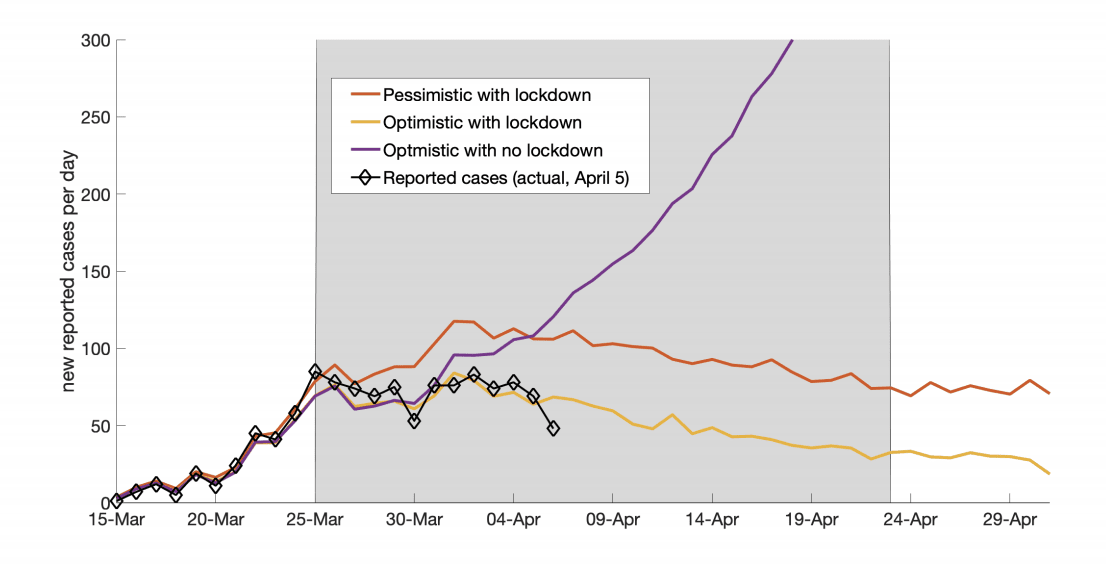
“We do seem to be tracking really well,” Hendy said.
“Even our optimistic scenario, if you look at the numbers, seems a bit conservative. If you’d asked us what our optimistic scenario was a week ago, we’d be a lot more pessimistic.”
If our controls continue to operate in line with the optimistic scenarios and our case isolation is fast enough, we can contain the virus:
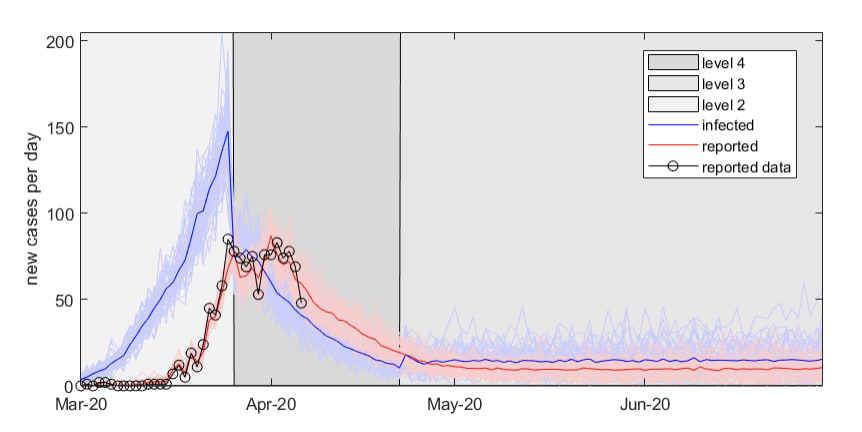
Meanwhile, even with fast case isolation, a “realistic” scenario results in another outbreak:
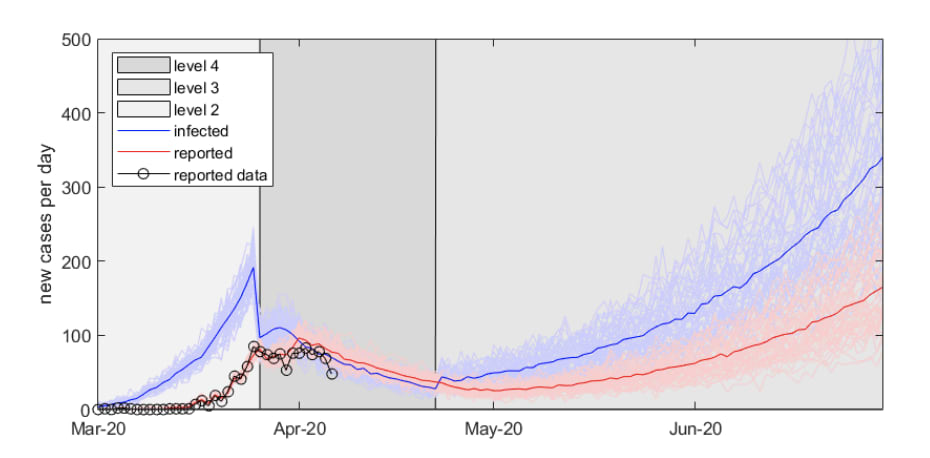
And under a realistic scenario where our case isolation is slower, things get out of control even faster:
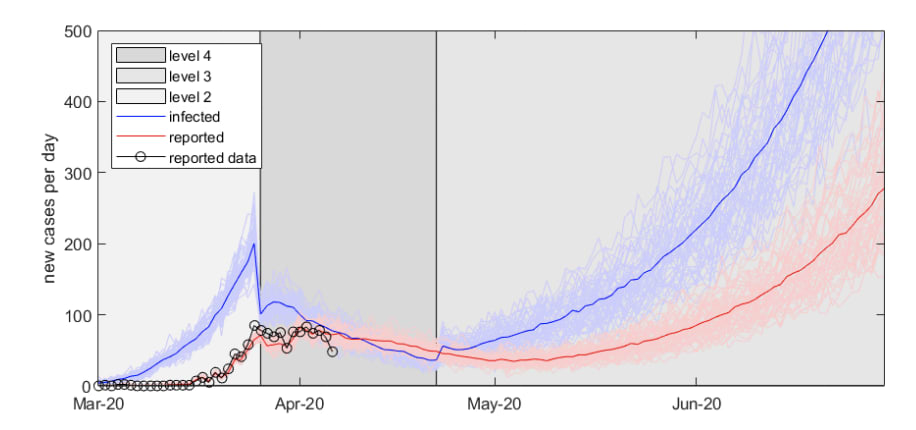
Despite these dire projections – and a new figure estimating around 100,000 deaths if a new outbreak strikes and New Zealand takes no action – the modellers are optimistic in their discussion of the results.
“Our results show that for small Covid-19 case numbers, such as those New Zealand is currently managing, rapid case isolation can play an important role. This opens up the possibility of containment or elimination, scenarios that are very distant for most other countries,” they write.
“An optimistic scenario with strong effective controls and rapid case isolation can contain the outbreak at the end of the four week Level 4 period.”
However, for true elimination of the virus – which is the Government’s stated goal – the modellers estimate that a 90-day lockdown is needed.
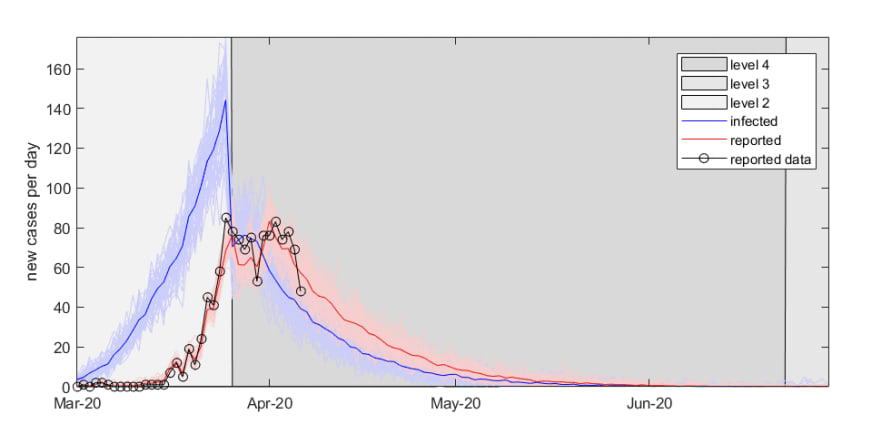
“We have also shown that rapid case isolation while case numbers are low can drive these effective reproduction numbers even lower,” they write.
“The results also show that an indication of New Zealand’s effective reproduction numbers should emerge in the coming weeks, giving a good sense of the likelihood of containment if numbers fall. Nevertheless, longer periods of strong population-wide controls will delay or reduce the risk of a further outbreak.”
However, Hendy is more optimistic about the chances of elimination than his paper. “That’s probably overly conservative,” he said.
“One of the things that the next version of the model looks at is regions. Basically it applies a similar set of scenarios to different regions around New Zealand. What we see is that some parts of the country can come out earlier than that. Once you undo that average over the whole country, you start to see a more complex picture.”
“I think there’s a chance that some regions can come out at the end of four weeks. It might be longer for others. And it kind of depends on whether you’re prepared to go back into lockdown. You can take a bit of a risk, you can come out a bit earlier, provided you’re prepared to go back into lockdown should those numbers balloon up again.”
“Again, we’re on the right side of the curve, and that gives us options.”
The introduction of other measures could also help dampen the virus’ ability to spread.
“Our results also suggest that different testing strategies (e.g. testing of essential services personnel with high numbers of contacts) followed by case isolation and contact tracing should also be considered as an additional control measure. New technologies that allow for faster contact tracing or testing should also be investigated,” the paper states.
“Improving the speed at which cases are isolated, by testing, tracing, or otherwise, will increase the chance of containment and elimination.”
Hendy said the bolstering of New Zealand’s testing and contract regimes will play a big role in reducing the time needed in lockdown.
“We are mustering up our contact tracing and testing. That’s been improving continuously over the last little while, so again, that probably means that our predictions are on the conservative side,” he said.
“In our paper, we assumed that at the early stage was going to be our fast stage. That’s because what’s happened in other countries is cases have grown, the effort they’ve had to extend to do their contact tracing also grows, so there has been quite a slowdown [in tracing and case isolation].”
New Zealand is different, however. “We’ve got the luxury of bringing those [case] numbers down at the same time as we’re ramping up resources,” he said.
“Again, we’re on the right side of the curve, and that gives us options.”



